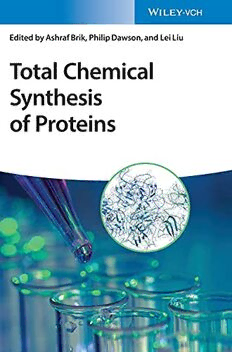
Total Chemical Synthesis of Proteins PDF
Preview Total Chemical Synthesis of Proteins
TotalChemicalSynthesisofProteins Total Chemical Synthesis of Proteins Edited by Ashraf Brik, Philip Dawson, and Lei Liu Editors AllbookspublishedbyWiley-VCHarecarefully produced.Nevertheless,authors,editors,and AshrafBrik publisherdonotwarranttheinformationcontained Technion-IsraelInst.ofTechnology inthesebooks,includingthisbook,tobefreeof SchulichFacultyofChemistry errors.Readersareadvisedtokeepinmindthat TechnionCity statements,data,illustrations,proceduraldetailsor 32000Haifa otheritemsmayinadvertentlybeinaccurate. Israel LibraryofCongressCardNo.: appliedfor PhilipDawson DepartmentofChemistry BritishLibraryCataloguing-in-PublicationData: TheScrippsResearchInstitute Acataloguerecordforthisbookisavailablefromthe 10550N.TorreyPinesRoad BritishLibrary. UnitedStates BibliographicinformationpublishedbytheDeutsche LeiLiu Nationalbibliothek TsinghuaUniversity TheDeutscheNationalbibliothekliststhis DepartmentofChemistry publicationintheDeutscheNationalbibliografie; HetianBuilding detailedbibliographicdataareavailableonthe 100084Beijing Internetat<http://dnb.d-nb.de>. China ©2021WILEY-VCHGmbH,Boschstr.12,69469 Weinheim,Germany Allrightsreserved(includingthoseoftranslation intootherlanguages).Nopartofthisbookmaybe reproducedinanyform–byphotoprinting, microfilm,oranyothermeans–nortransmittedor translatedintoamachinelanguagewithoutwritten permissionfromthepublishers.Registerednames, trademarks,etc.usedinthisbook,evenwhennot specificallymarkedassuch,arenottobeconsidered unprotectedbylaw. PrintISBN:978-3-527-34660-8 ePDFISBN:978-3-527-82357-4 ePubISBN:978-3-527-82358-1 oBookISBN:978-3-527-82356-7 Typesetting SPiGlobal,Chennai,India Printedonacid-freepaper 10 9 8 7 6 5 4 3 2 1 v Contents Preface xvii 1 CharacterizationofProteinMoleculesPreparedbyTotal ChemicalSynthesis 1 StephenB.H.Kent 1.1 Introduction 1 1.2 ChemicalProteinSynthesis 2 1.3 CommentsonCharacterizationofSyntheticProteinMolecules 8 1.3.1 Homogeneity 8 1.3.2 AminoAcidSequence 9 1.3.3 ChemicalAnalogues 10 1.3.4 LimitationsofSPPS 10 1.3.5 FoldingasaPurificationStep 10 1.4 Summary 12 References 12 2 AutomatedFastFlowPeptideSynthesis 17 MarkD.Simon,AlexanderJ.Mijalis,KyleA.Totaro,DanielDunkelmann, AlexanderA.Vinogradov,ChiZhang,YutaMaki,JustinM.Wolfe,Jessica Wilson,AndreiLoas,andBradleyL.Pentelute 2.1 Introduction 17 2.2 Results 19 2.2.1 Summary 19 2.2.1.1 MechanicalPrinciples 20 2.2.1.2 ChemicalPrinciples 20 2.2.1.3 UserInterfacePrinciples 20 2.2.1.4 DataAnalysisMethod 20 2.2.1.5 Outcome 21 2.2.2 First-generationAutomatedFastFlowPeptideSynthesis 21 2.2.2.1 KeyFindings 21 2.2.2.2 DesignofFirst-generationAFPS 21 2.2.2.3 CharacterizationofFirst-generationAFPS 23 2.2.3 Second-generationAutomatedFastFlowPeptideSynthesis 24 vi Contents 2.2.3.1 KeyFindings 24 2.2.3.2 DesignofSecond-generationAFPS 24 2.2.3.3 CharacterizationandUseofSecond-generationAFPS 26 2.2.4 Third-generationAutomatedFastFlowPeptideSynthesis 32 2.2.4.1 KeyFindings 32 2.2.4.2 DesignofThird-generationAFPS 34 2.2.4.3 CharacterizationofThird-generationAFPS 39 2.2.4.4 ReagentStabilityStudy 43 2.2.5 Fourth-generationAutomatedFastFlowPeptideSynthesis 45 2.2.5.1 KeyFindings 45 2.2.5.2 EffectofSolventonFastFlowSynthesis 45 2.2.5.3 DesignandCharacterizationofFourth-generationAFPS 45 2.3 Conclusions 49 Acknowledgments 53 References 53 3 N,S-andN,Se-AcylTransferDevicesinProteinSynthesis 59 VincentDiemer,JenniferBouchenna,FlorentKerdraon,VangelisAgouridas, andOlegMelnyk 3.1 Introduction 59 3.2 N,S-andN,Se-AcylTransferDevices:GeneralPresentation,Reactivity andStatisticalOverviewofTheirUtilization 61 3.2.1 GeneralPresentationofN,S-andN,Se-AcylTransferDevices 61 3.2.2 RelativeReactivityofN,S-andN,Se-AcylTransferDevices 63 3.2.3 AStatisticalOverviewoftheSyntheticUseofN,S-andN,Se-Acyl TransferDevicesforProteinTotalChemicalSynthesis 64 3.3 PreparationofSEA/SeEAoffandSEAlidePeptides 68 3.3.1 PreparationofSEAandSeEAPeptides 68 3.3.2 PreparationofSEAlidePeptides 70 3.4 Redox-controlledAssemblyofBiotinylatedNK1Domainofthe HepatocyteGrowthFactor(HGF)UsingSEAandSeEAChemistries 71 3.5 TheTotalChemicalSynthesisofGM2-APUsingSEAlide-based Chemistry 75 3.6 Conclusion 79 References 80 4 ChemicalSynthesisofProteinsThroughNativeChemical LigationofPeptideHydrazides 87 ChaoZuo,XiaodanTan,XianglongTan,andLeiLiu 4.1 Introduction 87 4.2 DevelopmentofPeptideHydrazide-basedNativeChemicalLigation 88 4.2.1 ConversionofPeptideHydrazidetoPeptideAzide 88 4.2.2 AcylAzide-basedSolid-phasePeptideSynthesis 88 4.2.3 AcylAzide-basedSolution-phasePeptideSynthesis 89 4.2.4 TheTransesterificationofAcylAzide 90 Contents vii 4.2.5 DevelopmentofPeptideHydrazide-basedNativeChemicalLigation 90 4.3 OptimizationofPeptideHydrazide-basedNativeChemicalLigation 91 4.3.1 PreparationofPeptideHydrazides 91 4.3.1.1 2-Cl-Trt-ClResin 91 4.3.1.2 PeptideHydrazidesfromExpressedProteins 92 4.3.1.3 Sortase-mediatedHydrazideGeneration 93 4.3.2 ActivationMethodsofPeptideHydrazide 94 4.3.2.1 KnorrPyrazoleSynthesis 94 4.3.2.2 ActivationinTFA 94 4.3.3 LigationSitesofPeptideHydrazide 95 4.3.4 MultipleFragmentLigationBasedonPeptideHydrazide 96 4.3.4.1 N-to-CSequentialLigation 96 4.3.4.2 ConvergentLigation 96 4.3.4.3 One-potLigation 96 4.4 ApplicationofPeptideHydrazide-basedNativeChemicalLigation 99 4.4.1 PeptideDrugsandDiagnosticTools 99 4.4.1.1 PeptideHydrazidesforCyclicPeptideSynthesis 99 4.4.1.2 ScreeningforDPeptideInhibitorsTargetingPD-L1 99 4.4.1.3 ChemicalSynthesisofDCAFforTargetedAntibodyBlocking 101 4.4.1.4 PeptideToxins 101 4.4.2 SynthesisandApplicationofTwo-photonActivatableChemokine CCL5 102 4.4.3 ProteinswithPosttranslationalModification 103 4.4.3.1 TheSynthesisofGlycosylation-modifiedFull-lengthIL-6 103 4.4.3.2 TheChemicalSynthesisofEPO 105 4.4.3.3 ChemicalSynthesisofHomogeneousPhosphorylatedp62 105 4.4.3.4 ChemicalSynthesisofK19,K48Bi-acetylatedAtg3Protein 105 4.4.4 UbiquitinChains 108 4.4.4.1 SynthesisofK27-linkedUbiquitinChains 108 4.4.4.2 SynthesisofAtypicalUbiquitinChainsbyUsinganIsopeptide-linkedUb Isomer 109 4.4.4.3 SynthesisofAtypicalUbiquitinChainsUsinganIsopeptide-linkedUb Isomer 109 4.4.5 ModifiedNucleosomes 110 4.4.5.1 SynthesisofDNA-barcodedModifiedNucleosomeLibrary 110 4.4.5.2 SynthesisofModifiedHistoneAnalogswithaCysteine Aminoethylation-assistedChemicalUbiquitinationStrategy 111 4.4.5.3 SynthesisofUbiquitylatedHistonesforExaminationofthe DeubiquitinationSpecificityofUSP51 111 4.4.6 MembraneProteins 112 4.4.7 Mirror-imageBiologicalSystems 112 4.5 SummaryandOutlook 113 References 114 viii Contents 5 ExpandingNativeChemicalLigationMethodologywith SyntheticAminoAcidDerivatives 119 EmmaE.Watson,LaraR.Malins,andRichardJ.Payne 5.1 NativeChemicalLigation 120 5.2 DesulfurizationChemistries 120 5.3 AsparticAcid(Asp,D) 122 5.4 GlutamicAcid(Glu,E) 124 5.5 Phenylalanine(Phe,F) 125 5.6 Isoleucine(Ile,I) 127 5.7 Lysine(Lys,K) 130 5.8 Leucine(Leu,L) 133 5.9 Asparagine(Asn,N) 135 5.10 Proline(Pro,P) 138 5.11 Glutamine(Gln,Q) 139 5.12 Arginine(Arg,R) 139 5.13 Threonine(Thr,T) 140 5.14 Valine(Val,V) 142 5.15 Tryptophan(Trp,W) 144 5.16 ApplicationofSelenocysteine(Sec)toLigationChemistry 146 5.17 AsparticAcid(Asp,D) 147 5.18 GlutamicAcid(Glu,E) 148 5.19 Phenylalanine(Phe,F) 149 5.20 Leucine(Leu,L) 151 5.21 Proline(Pro,P) 151 5.22 Serine(Ser,S) 153 References 155 6 PeptideLigationsatStericallyDemandingSites 161 YingluWangandSuweiDong 6.1 Introduction 161 6.2 LigationsUsingThioesters 162 6.2.1 ExogenousAdditive-promotedLigations 162 6.2.2 LigationsUsingReactiveThioesters 167 6.2.3 InternalActivationStrategyinPeptideLigations 169 6.3 LigationsUsingOxo-esters 170 6.4 PeptideLigationsBasedonSelenoesters 170 6.5 Microfluidics-promotedNCL 175 6.6 RepresentativeApplicationsinProteinSynthesis 178 6.7 SummaryandOutlook 181 References 181 7 ControllingSegmentSolubilityinLargeProtein Synthesis 185 RileyJ.Giesler,JamesM.Fulcher,MichaelT.Jacobsen,andMichaelS.Kay 7.1 SolventManipulation 185 Contents ix 7.2 IsoacylStrategy 187 7.3 SemipermanentSolubilizingTags 191 7.3.1 N-orC-TerminalSolubilizing“Tails” 192 7.3.2 ReversibleBackboneModificationsasSolubilizingTags 194 7.3.3 BuildingBlockSolubilizingTags 195 7.3.4 ExtendableSide-chain-basedSolubilizingTags 195 References 198 8 TowardHPLC-freeTotalChemicalSynthesisofProteins 211 PhucUngandOliverSeitz 8.1 Introduction 211 8.1.1 CaptureandReleasePurification 212 8.1.2 Solid-phaseChemicalLigations(SPCL) 212 8.2 SynthesisofPeptideSegmentsforNativeChemicalLigation 213 8.2.1 HPLC-freePreparationofN-terminalPeptideSegmentsforNCL 213 8.2.2 HPLC-freePreparationofC-terminalPeptideSegmentsforNCL 217 8.3 SynthesisofProteinsUsingtheHis Tag 220 6 8.3.1 ReversibleHis -basedCaptureTags 220 6 8.3.2 His -basedImmobilizationforC-to-NAssemblyofCrambin 221 6 8.3.3 His -basedImmobilizationforAssemblyofProteinsonMicrotiter 6 Plates 222 8.3.4 His andHydrazideTagsforSequentialN-to-CCaptureand 6 Release 225 8.4 SynthesisofProteinsviaOximeFormation 227 8.4.1 ReversibleOxime-basedCaptureTags 227 8.4.2 Oxime-basedImmobilizationforN-to-CSolid-phaseChemical Ligations 227 8.4.3 Oxime-basedImmobilizationforC-to-NSolid-phaseChemical Ligations 233 8.4.4 Oxime-basedC-to-NSolid-phaseChemicalLigations 237 8.5 SynthesisofProteinsviaHydrazoneFormation 238 8.5.1 ReversibleHydrazone-basedCaptureTags 238 8.5.2 Hydrazone-basedImmobilizationforAssemblyofProteinsonMicrotiter Plates 239 8.6 SynthesisofProteinsUsingClickChemistry 242 8.6.1 Click-basedImmobilizationforN-to-CSolid-phasePeptideLigations UsingaProtectedAlkyne 242 8.6.2 Click-basedImmobilizationforN-to-CSolid-phasePeptideLigations UsingaSeaGroup 243 8.7 SynthesisofProteinsUsingtheKAHALigation 244 8.7.1 TheKAHALigation 244 8.7.2 HPLC-freeSynthesisofProteinsUsingtheKAHALigation 245 8.8 SynthesisofProteinsUsingPhotocleavableTags 246 8.8.1 SynthesisofProteinsUsingaPhotocleavableBiotin-basedPurification Tag 246 x Contents 8.8.2 SynthesisofProteinsUsingaPhotocleavableHis -basedPurification 6 Tag 247 8.9 Conclusion 249 References 251 9 Solid-phaseChemicalLigation 259 SkanderA.Abboud,AgnèsF.Delmas,andVincentAucagne 9.1 Introduction 259 9.1.1 ThePromisesofSolidPhaseChemicalLigation(SPCL) 259 9.1.2 ChemicalLigationReactionsUsedforSPCL 260 9.1.3 KeyRequirementsforaSPCLStrategy 261 9.2 SPCLintheC-to-NDirection 262 9.2.1 TemporaryMaskingGroupstoEnableIterativeLigations 262 9.2.2 LinkersforC-to-NSPCL 264 9.2.2.1 UseofSameLinkerandSolidSupportforSPPSandSPCL 265 9.2.2.2 Re-immobilizationoftheC-TerminalSegment 266 9.3 SPCLintheN-to-CDirection 268 9.3.1 TemporaryMaskingGroupstoEnableIterativeLigations 268 9.3.2 LinkersforN-to-CSPCL 270 9.3.3 CaseStudy 272 9.3.4 SPCLwithConcomitantPurifications 274 9.4 Post-LigationSolid-SupportedTransformations 274 9.4.1 ChemicalTransformations 274 9.4.2 BiochemicalTransformations 275 9.5 SolidSupport 275 9.6 ConclusionandPerspectives 278 Acknowledgment 278 9.A Appendix 278 References 280 10 Ser/ThrLigationforProteinChemicalSynthesis 285 CarinaHeyPuiCheungandXuechenLi 10.1 Serine/ThreonineLigation 287 10.2 EpimerizationIssue 289 10.3 OtherArylAldehydeEsters 289 10.4 PreparationofPeptideSalicylaldehydeEsters 289 10.5 ScopeandLimitations 294 10.6 StrategiesofSer/ThrLigationforProteinChemicalSynthesis 294 10.7 C-to-NSer/ThrLigation 294 10.8 N-to-CSer/ThrLigation 296 10.9 One-potSer/ThrLigationandNCL 296 10.10 Bioconjugation 296 10.11 SolubilityIssues 298 10.12 ExtensionofSer/ThrLigation 298 10.13 Conclusion 302 References 303
